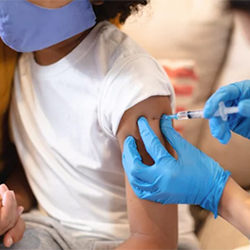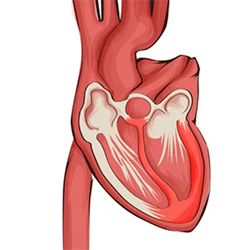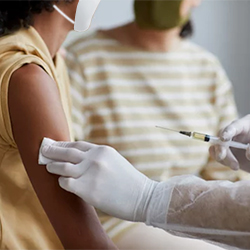By Marie Rosenthal, MS
Shortly after the CDC’s Advisory Committee on Immunization Practices (ACIP) voted 14 to 0 to recommend the Pfizer-BioNTech COVID-19 vaccine for children 5 to 11 years of age, CDC Director Rochelle Walensky, MD, MPH, endorsed the recommendation.

The 10 mcg vaccine should be given in two doses, 21 days apart, as indicated by the FDA.
The ACIP considered a data presentation by Pfizer, as well as CDC presentations about the epidemiology of the SARS-CoV-2 virus on children, particularly in this age group; the severe, but rare myocarditis adverse event seen in vaccinated teens and young adults; as well as information about the vaccine surveillance system before making its decision.
Grace Lee, MD, MPH, the associate chief medical officer for practice innovation at the Lucile Packard Children’s Hospital and the chair of the ACIP, said that she was voting for the vaccination because “I value preventing infection and children, and I think it can have a huge positive impact on their health, their social and emotional well-being, their educational outcomes and their long term trajectory.
“While we do have other ways to prevent infections such as masking, we know that there are substantial variability in the use of masks in school settings, and that transmission can occur and vaccines are really the only consistent and reliable way that we can provide that protection other than cocooning them at home to minimize their risk, but then that is depriving them of many other sort of important aspects of their childhood.
“I'll also just emphasize that we really need to continue to invest resources and effort in understanding the broader health and non-health impact of COVID infections in the pediatric population,” she added. “But I am hopeful that this will take us one step along that journey.”
In a rare move, Dr. Walensky addressed the panel at the start of the meeting, calling today a “monumental day in the course of this pandemic, and one that many of us have been very eager to see ever since your vote on Dec. 12 last year recommending COVID-19 vaccination for those 16 and older.
“We have been asking when we will be able to expand this protection to our younger children.”
She asked the panel to keep in mind the specific risks to children from the pandemic, not only potential severe disease, multisystem inflammatory syndrome in children and long-haul COVID-19, but also spoke of the social and mental health affects of missing school and social activities with their friends.
“I also think that I share with your perspective that pediatric vaccination is just one important piece to this puzzle,” she said. “It is important that we also can continue to vaccinate as many adults as possible to provide protection to children in the community, including those younger than 5, who may not be eligible yet for vaccination.
As cases began to rise because of Delta, “there were stark differences in pediatric cases based on community vaccination level,” she said. In communities with high rates of vaccination, there were fewer children hospitalized with COVID-19.
“It is our ongoing responsibility to make sure as many people as possible are vaccinated and protected,” she said.
Effect on Children
More than 1.9 million children 5 to 11 years old have been diagnosed with COVID-19, and children in this age range comprise a portion of total cases (10.6%) than before, explained Jefferson Jones, MD, MPH, a pediatrician and epidemiologist at the CDC. “Starting in July and August of this year, there was a sharp increase of cases in this age group,” he said.
He presented data from FluSurv-NET and COVID-NET that showed outcomes of children ages 5 to 11. FluSurv-NET receives surveillance information from parts of California, Colorado, Connecticut, Georgia, Maryland (Baltimore Metropolitan Area), Michigan, Minnesota, New Mexico, New York, Ohio, Oregon, Tennessee and Utah from Oct. 1 to April 30 each influenza season COVID-NET receives information from parts of California, Colorado, Connecticut, Georgia, Iowa, Maryland (entire state), Michigan, Minnesota, New Mexico, New York, Ohio, Oregon, Tennessee and Utah.
He compared three pre-pandemic influenza seasons with one year of COVID-19. In 2017-2018, 2018-2019, and 2019-2020, influenza seasons, an estimated 1,874 children in this cohort were hospitalized. Of those, 398 required ICU admission; 87 invasive mechanical ventilation and 11 died. Between Mar 1, 2020 to Aug. 31, 2021, 696 children were hospitalized with COVID-19. Of those, 222 required ICU admission, 50 invasive mechanical ventilation and four died. Thirty-two percent had no underlying condition that would put them at risk for hospitalization, he added.
Across the country, an estimated 66 children between 5 and 11 have died between Oct. 3, 2020 and Oct. 2, 2021, he added, which ties it with suicide as the eight leading cause of death in these children.
The Infectious Diseases Society of America (IDSA) and the Pediatric Infectious Diseases Society (PIDS) issued a statement saying they supported the FDA and CDC decisions to authorize the Pfizer-BioNTech COVID-19 vaccine for children aged 5-11 years.
"To date, 6 million children have been diagnosed with COVID-19. The more than 28 million children who will be eligible to be vaccinated against COVID-19 with this authorization comprise a larger portion of the population than the already eligible 12-17-year-old cohort. Vaccination will provide these children with critical protection against serious disease and hospitalization and help bolster overall immunity in the community," said Daniel P. McQuillen, MD, FIDSA, the president of IDSA, and Buddy Creech, MD, MPH, FPIDS, the president of PIDS.
"Vaccinating school-aged children has other benefits. It will limit disruption in school attendance, allowing children to safely participate in learning and other activities that are crucial for mental health and development.
It's also a good time to ensure that children are up to date on all of the recommended vaccines, including seasonal influenza. Vaccinate, they reminded.
The Data
Pfizer presented data from a phase 2/3 randomized controlled trial that included about 4,500 children 5 to 11 years of age (2,268 from the original group and 2,379 from the supplemental safety group). The participants received two 10 mcg doses administered 21 days apart. The trial showed a vaccine efficacy rate of 90.7% in participants without previous SARS-CoV-2 infection, measured from seven days after the second dose.
This dose is one-third of the 30-mcg dose used for people 12 years and older, said Alejandra Gurtman, MD, the vice president of vaccine clinical research and development at Pfizer, and no serious safety concerns related to the vaccine were seen, including myocarditis.
However, Matt Oster, MD, MPH, a pediatric cardiologist at Children’s Healthcare of Atlanta, and a medical officer at the CDC, said that myocarditis is such a rare side effect, that thousands more children would have had to be included in the study to see this effect.
Tom Shimabukuro, MD, MPH, MBA, the deputy director of H1N1 Vaccine Task Force at the CDC, said that vaccine safety will be continually monitored through several surveillance systems and urged parents, pediatricians and other physicians, pharmacists and others to report any adverse event that they think was related to vaccination—even if they are unsure.
“Your participation does matter,” he said. “We encourage people to report to VAERS [Vaccine Events Reporting System]. We depend on people to report to VAERS.”
the CDC said tha distribution of the pediatric vaccinations would begin this week, with plans to scale up to full capacity starting the week of Nov. 8. Vaccines will be available at pediatrician's and other health care provider offices, pharmacies, Federally Qualified Health Centers and other venues.




